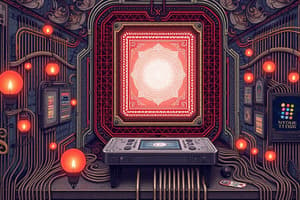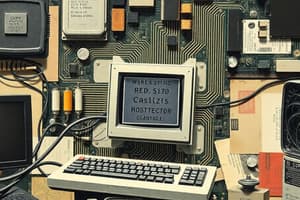Podcast
Questions and Answers
Data deletion involves removing data to protect sensitive ______.
Data deletion involves removing data to protect sensitive ______.
information
Utility software aids in analyzing, optimizing, and maintaining computer ______.
Utility software aids in analyzing, optimizing, and maintaining computer ______.
systems
The main function of operating systems is to manage ______ capabilities.
The main function of operating systems is to manage ______ capabilities.
processing
A ______ satisfies specific needs in a particular environment.
A ______ satisfies specific needs in a particular environment.
Compilers and interpreters are types of ______ processing tools.
Compilers and interpreters are types of ______ processing tools.
The ______ is known as the primary component that processes instructions in a computer.
The ______ is known as the primary component that processes instructions in a computer.
Input/output units facilitate the transmission of information between the external world and computer ______.
Input/output units facilitate the transmission of information between the external world and computer ______.
Primary memory provides ______ storage for data during processing.
Primary memory provides ______ storage for data during processing.
Secondary memory is required for ______ storage of data not retained by primary memory.
Secondary memory is required for ______ storage of data not retained by primary memory.
______ devices include keyboards, mice, and scanners, which are used to input data into the computer system.
______ devices include keyboards, mice, and scanners, which are used to input data into the computer system.
Output devices, such as monitors and printers, are used to display ______ processed information.
Output devices, such as monitors and printers, are used to display ______ processed information.
The smallest unit of data in memory is known as a ______.
The smallest unit of data in memory is known as a ______.
Examples of secondary storage technologies include hard drives and ______.
Examples of secondary storage technologies include hard drives and ______.
Flashcards are hidden until you start studying
Study Notes
Computer Functionality
- Computers process data, perform calculations, and execute tasks using instructions from programs.
- Involves input from users or external devices, processing by the CPU, and output to display results.
Evolution of Computing Devices
- Initial devices were mechanical; evolved to electromechanical, and then into digital computers.
- Progression includes mainframes, personal computers, laptops, and smartphones.
Central Processing Unit (CPU)
- Often referred to as the "brain" of the computer, executing instructions from programs.
- Comprises arithmetic logic unit (ALU) and control unit (CU) for processing operations.
- The clock speed and architecture impact performance and speed of the CPU.
Input/Output Unit
- Serves as the interface between the computer and the external environment.
- Transmits information to be processed and displays or records output results.
Overview of Input/Output Units
- Data input is processed and stored in memory; results are displayed or recorded via output units.
Memory Unit
- Temporary storage area for instructions and data, facilitating processing tasks.
- Critical for quick retrieval of data and results during operation.
Primary Memory
- Connected directly to the CPU, holds data for immediate access.
- Volatile memory, meaning data is lost when power is turned off.
Secondary Memory
- Used for long-term data storage; retains information even without power.
- Includes devices like hard drives, SSDs, and optical discs.
Input Devices
- Keyboards, mice, touchscreens, and scanners are examples used for data entry.
- Essential for interaction with the computer system.
Output Devices
- Monitors, printers, and projectors display data processed by the computer.
- Communicates results to the user.
Memory Units Overview
- Data is represented in bits and bytes, ranging from basic units (bits) to extensive storage measures (yottabytes).
- Each unit corresponds to specific quantities of data (e.g., 1 byte = 8 bits).
Primary Memory Details
- Provides quick, temporary access to data during processing cycles.
- Crucial for efficient multitasking and performance.
Secondary Memory Examples
- Technologies like HDDs and SSDs are vital for storing large amounts of information.
- USB drives and optical discs serve as portable storage options.
Data Deletion and Recovery
- Data can be intentionally deleted to free up space or protect sensitive information.
- Recovery processes exist to retrieve accidentally or intentionally deleted data.
Security Concerns
- Importance of securely deleting personal and sensitive information to prevent data breaches.
- Implementing strong security measures for data preservation and recovery.
Reasons for Deleting Data
- Common motives include improving system performance, freeing up storage, or protecting privacy.
Data Recovery Process
- Involves various techniques to restore lost data due to deletion, corruption, or hardware failure.
Definition and Scope of Computer Security
- Encompasses measures taken to protect computer systems and data from unauthorized access or damage.
Main Concerns
- Frequent security threats include malware, hacking, data breaches, and phishing attacks.
Definition and Purpose of Software
- Software is a collection of instructions enabling computers to perform specific tasks and functions.
Types of Software
- System Software: Manages hardware and software resources; examples include Operating Systems.
- Application Software: Designed for end-users to fulfill specific needs; examples include Microsoft Office.
- Utility Software: Helps maintain and optimize computer systems; examples include antivirus and disk cleanup tools.
Functions of Operating System
- Manages hardware resources, provides user interface, and enables application execution.
- Handles system operations such as memory management and process scheduling.
Types of Operating Systems
- Includes batch, time-sharing, distributed, embedded, real-time, and mobile operating systems, catering to various computing needs.
Compiler and Interpreter
- Compilers translate high-level code into machine code before execution; interpreters execute code line-by-line during runtime.
Difference Between Compiler and Interpreter
- Compilers produce a standalone executable file, enhancing performance; interpreters allow immediate execution but might slow down performance.
Studying That Suits You
Use AI to generate personalized quizzes and flashcards to suit your learning preferences.




